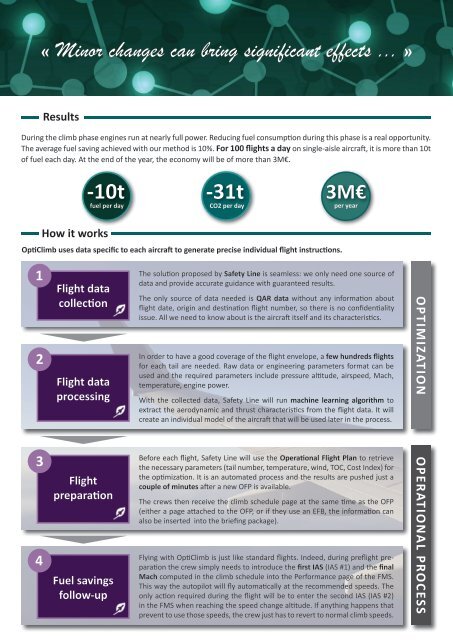OPTI CLIMB
1YLf2KK
1YLf2KK
You also want an ePaper? Increase the reach of your titles
YUMPU automatically turns print PDFs into web optimized ePapers that Google loves.
« Minor changes can bring significant effects ... »<br />
Results<br />
During the climb phase engines run at nearly full power. Reducing fuel consumption during this phase is a real opportunity.<br />
The average fuel saving achieved with our method is 10%. For 100 flights a day on single-aisle aircraft, it is more than 10t<br />
of fuel each day. At the end of the year, the economy will be of more than 3M€.<br />
-10t -31t 3M€<br />
fuel per day CO2 per day per year<br />
How it works<br />
OptiClimb uses data specific to each aircraft to generate precise individual flight instructions.<br />
1<br />
2<br />
3<br />
Flight data<br />
collection<br />
Flight data<br />
processing<br />
Flight<br />
preparation<br />
The solution proposed by Safety Line is seamless: we only need one source of<br />
data and provide accurate guidance with guaranteed results.<br />
The only source of data needed is QAR data without any information about<br />
flight date, origin and destination flight number, so there is no confidentiality<br />
issue. All we need to know about is the aircraft itself and its characteristics.<br />
In order to have a good coverage of the flight envelope, a few hundreds flights<br />
for each tail are needed. Raw data or engineering parameters format can be<br />
used and the required parameters include pressure altitude, airspeed, Mach,<br />
temperature, engine power.<br />
With the collected data, Safety Line will run machine learning algorithm to<br />
extract the aerodynamic and thrust characteristics from the flight data. It will<br />
create an individual model of the aircraft that will be used later in the process.<br />
Before each flight, Safety Line will use the Operational Flight Plan to retrieve<br />
the necessary parameters (tail number, temperature, wind, TOC, Cost Index) for<br />
the optimization. It is an automated process and the results are pushed just a<br />
couple of minutes after a new OFP is available.<br />
The crews then receive the climb schedule page at the same time as the OFP<br />
(either a page attached to the OFP, or if they use an EFB, the information can<br />
also be inserted into the briefing package).<br />
4<br />
Flying with OptiClimb is just like standard flights. Indeed, during preflight preparation<br />
the crew simply needs to introduce the first IAS (IAS #1) and the final<br />
Fuel savings<br />
follow-up<br />
Mach computed in the climb schedule into the Performance page of the FMS.<br />
This way the autopilot will fly automatically at the recommended speeds. The<br />
only action required during the flight will be to enter the second IAS (IAS #2)<br />
in the FMS when reaching the speed change altitude. If anything happens that<br />
prevent to use those speeds, the crew just has to revert to normal climb speeds.<br />
<strong>OPTI</strong>MIZATION OPERATIONAL PROCESS


